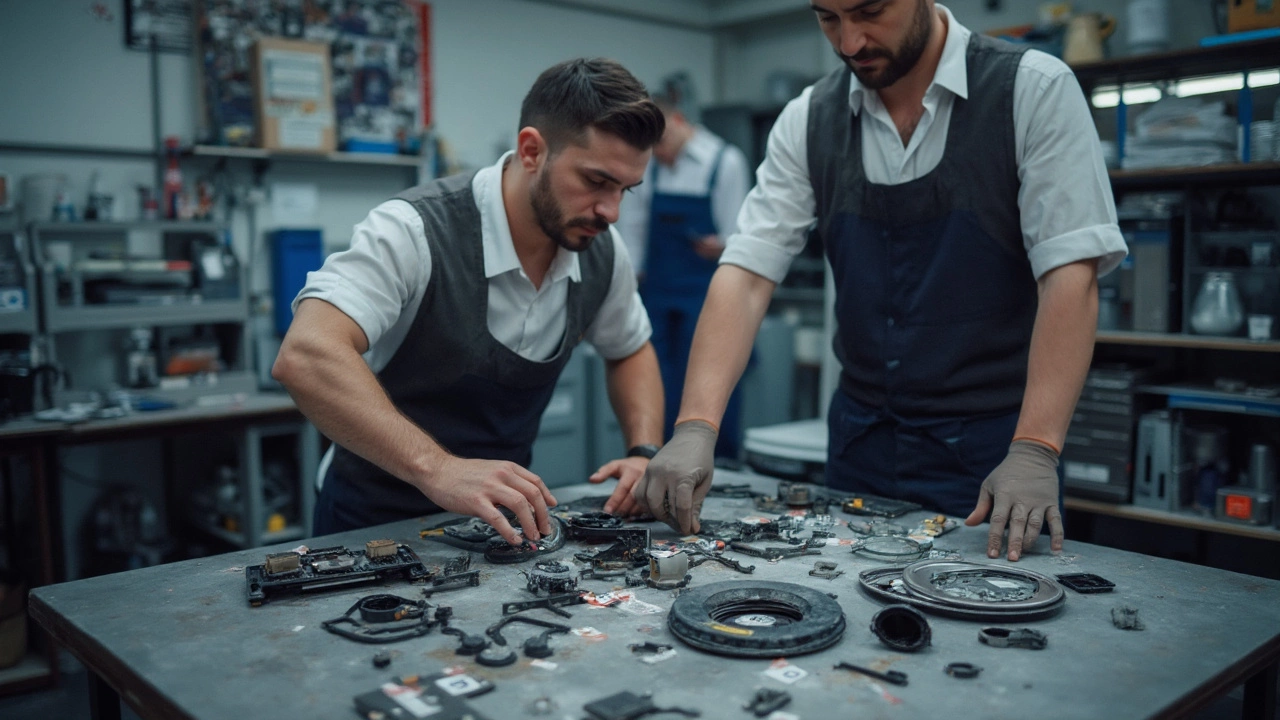Ever get that sinking feeling when your washer makes a weird noise? You're not alone. Lots of folks freak out over repair bills, especially when it comes to certain parts. Here’s the thing: not all washer breakdowns are created equal. Some fixes are quick and cheap, while others? Well, they can feel like a punch to the gut—and wallet.
If you've heard buzzing about “expensive washer repairs,” you’re probably wondering which parts are the real money pits. Spoiler: one part regularly tops the list and, trust me, it’s a doozy if it goes bad. Knowing the most expensive part to replace not only helps you brace for impact but might also give you a few tricks for dodging giant repair bills down the road.
Stick around, because I’m walking you through what actually drives up the cost, which part drains your bank account fastest, and a few practical tips to either spot trouble early or even side-step it. Let’s get into the nitty-gritty and help save you some cash—and maybe some stress, too.
- Why Washing Machine Repairs Can Get Pricey
- The Drum: The Costliest Culprit
- Control Boards: Tiny Tech, Big Expense
- Motor and Transmission: The Muscle Behind the Machine
- Signs a Major Part Is About to Fail
- When to Repair, When to Replace
Why Washing Machine Repairs Can Get Pricey
Most people are shocked when a simple washing machine fix turns into a three-digit bill. It’s not just the parts themselves. Modern washers are crammed with sensors, circuit boards, and heavy-duty hardware, so repairs aren’t quick and easy anymore. Sometimes, getting your washer back up and running means more than just swapping out a part—it can mean almost rebuilding the thing.
One reason costs keep creeping up is how complicated machines have gotten in the last ten years. What used to be a metal box with knobs now has touchscreens, Wi-Fi, and loads of internal gadgets. Trying to fix stuff like the main board or the motor isn’t something most people want to try at home. That drives up labor costs, since you need a skilled tech for the job. Plus, good luck finding the exact part at a local hardware store—most high-end parts are special order and can take days (or weeks) to show up.
Another factor is the weight and size of components. For example, the drum can weigh over 40 pounds, and replacing it usually means tearing the machine nearly apart. That’s hours on the clock for a repair person, which translates to a bigger bill for you.
Honestly, even smaller jobs get pricey once you add up labor, diagnostic fees, and the cost of shipping parts. You end up wondering if it’s even worth fixing certain things.
Here’s a quick look at what typically bumps up washing machine repair costs:
- Complex electronics and sensors that need precise handling
- Time-intensive labor, especially for big internal parts
- Limited access to certain replacement components
- Diagnostic fees most shops charge before they’ll even touch your washer
Check out some average national repair costs so you know what you’re up against:
| Repair Type | Average Cost (USD) |
|---|---|
| Drum Replacement | $350–$600 |
| Control Board Replacement | $250–$400 |
| Motor Replacement | $200–$450 |
| Transmission Replacement | $300–$500 |
| Minor Repairs (hoses, belts, etc.) | $75–$150 |
The bottom line? When you factor in everything—specialized parts, serious labor, and sometimes even home visits—washing machine repairs don’t come cheap, especially for the core stuff that keeps the machine running.
The Drum: The Costliest Culprit
If you've ever peeked inside your washer, you know the drum is the big metal tub where you toss your clothes. What a lot of people don't realize is this part isn’t just some empty shell. It's packed with balancing weights, bearings, gaskets, and sometimes fancy shock absorbers, all working together to keep your washer running smoothly at high speeds.
You’ve probably heard folks at appliance shops mention just how pricey drums are to fix or swap out. That’s not an exaggeration. In most modern washers, replacing the drum can easily set you back $400–$700, sometimes even more if you have a high-end or smart washing machine. Check out this breakdown:
| Washer Type | Drum Replacement Cost (Parts & Labor) |
|---|---|
| Top-Loader (Basic) | $300–$500 |
| Front-Loader (Standard) | $400–$600 |
| High-End Models | $600–$900 |
That price tag is mostly due to how the drum is built into the machine. Getting it out means near-complete disassembly—more hours for labor, which means bigger bills. Some brands actually seal their drums inside molded tubs, so even a tiny bearing failure means replacing the whole assembly. No wonder repair shops warn about this one.
As Steve Ash, a veteran appliance tech, put it:
"Washing machine drums are by far the most expensive part to replace, not only because of the part cost but also the incredible amount of labor. Sometimes, it’s cheaper to buy a new washer."
That idea stings, but it's often true. If your machine is older or out of warranty, fixing the drum rarely makes sense. Here are a few things that usually signal drum problems:
- Grinding or banging noises during spin cycles
- Water leaks near the bottom of the washer
- The drum feels loose or wobbly when you spin it by hand
- Visible cracks or rust inside the drum
If you notice any of these, don’t wait. Call a pro or at least check your washer’s warranty. With how expensive a drum repair gets, acting early can make all the difference. If your machine is still pretty new, some brands will cover certain drum failures up to ten years—always double-check that before shelling out for a costly repair out of pocket.
Control Boards: Tiny Tech, Big Expense
The control board is basically the brain of your washing machine. It manages cycles, water levels, spin speeds—almost everything the machine does is routed through this little circuit board. When it fails, your washer may not start, could stop mid-cycle, or might throw up random error codes that make you want to pull your hair out.
What’s wild is just how expensive these things can get. Depending on your machine’s make and age, replacing a control board often means hundreds out of your pocket. For some models, parts alone can run $150 to $400, not even counting labor. That’s a lot for a palm-sized piece of tech! Brands with fancy digital displays—think LG, Samsung, Whirlpool—usually charge more, especially for newer models loaded with touchscreens and smart features.
Take a look at some average replacement costs pulled from real repair shops in 2024:
| Brand | Control Board Cost (Part Only) | Estimated Total (with Labor) |
|---|---|---|
| Samsung | $220 - $370 | $350 - $550 |
| LG | $180 - $330 | $320 - $500 |
| Whirlpool | $150 - $280 | $280 - $450 |
The crazy part: a washing machine repair involving the control board sometimes costs nearly as much as a basic new washer. That’s why so many people toss in the towel and buy new instead of dealing with the repair headache.
Here’s what you can do to maximize your control board’s life:
- Keep your washer dry—moisture is a control board’s sworn enemy.
- Don’t overload the machine, which can trigger software errors.
- If you see a weird error code, consult your manual or look it up before you panic—it’s not always the board at fault.
- If your house gets lots of power surges, use a surge protector. Power spikes love to fry these things.
If your washer is still under warranty, call the manufacturer before spending a dime. And if you’re comfortable with electronics, you can sometimes order the right board online and swap it yourself—just make sure it’s the actual culprit and not a loose wire or sensor acting up.

Motor and Transmission: The Muscle Behind the Machine
The washing machine’s motor and transmission do all the heavy lifting. If these go out, you’re looking at one of the highest repair jobs, often second only to the drum. The motor is what spins and agitates your load, while the transmission helps shift all that motion. When either fails, your washer’s not just noisy or slow – it can totally stop working.
Replacement motors and transmissions aren’t cheap. A new motor can hit the $200–$400 range just for the part, and adding labor easily doubles the price. Transmissions are right up there too. Here’s a breakdown of what these repairs can cost when you call in a pro:
| Part | Average Cost (Part Only) | Total with Labor |
|---|---|---|
| Motor | $200–$400 | $350–$600 |
| Transmission | $150–$350 | $300–$550 |
There are some signs your motor or transmission is on its last legs:
- Washer won’t spin or agitate, even with a full load
- Loud grinding, humming, or clunking noises during cycles
- The drum turns, but doesn’t seem to have strength
- Burnt smells coming from the back or bottom of the machine
It’s worth checking if your model is under warranty before dropping cash on these repairs. On older machines, putting a few hundred bucks into the motor or transmission often makes less sense—sometimes it’s smarter to put that money toward a new washer instead. Regularly keeping lint and dirt from building up around the motor can help it last longer. Also, never overload the washer—this is a big reason these key parts give out early.
If you’re facing one of these repairs, get a quote and compare it to your washer’s age and replacement cost. A strong, healthy motor and transmission keep things running, but when they quit, it’s usually a major fork in the road for your laundry room.
Signs a Major Part Is About to Fail
You don’t need to be a repair tech to know when your washing machine is waving a red flag. The trick is spotting those warning signs early, especially when it comes to the big-ticket parts like the drum, control board, and motor. Catching problems before they get worse can save you a lot of money and hassle.
Watch out for these clear signals your washer’s priciest parts could be on the way out:
- Thumping or grinding sounds during the spin cycle usually mean trouble with the drum or bearings. If your machine sounds like a pair of shoes tumbling in the dryer (when there aren’t any in there), don’t ignore it.
- Water leaking from the bottom of the washer often points to a drum seal or bearing problem. A sudden puddle means it’s time to act fast.
- Error codes on your washer’s display can mean a failing control board. If the machine starts acting “possessed,” running random cycles or not responding to commands, it’s likely the brains of the operation are at risk.
- Drum not spinning or spinning very slowly is another red flag. This can be a motor issue or sometimes a transmission problem. If it’s struggling, it’s not just a bad day—it’s a possible repair bill coming your way.
- Excessive vibration and walking (when the washer moves across the floor) could mean the drum is off-balance or the suspension has gone bad. If the drum is damaged, that’s not a cheap fix.
If you spot any of these warning signs, don’t wait. Turning a blind eye can let small problems balloon into huge, expensive repairs that hit right at the heart of washing machine repair costs. A quick check by a pro now can stop you from shelling out big bucks later.
When to Repair, When to Replace
Sometimes fixing your machine is a no-brainer. But sometimes, replacing makes way more sense—especially if you’re staring down the barrel of a huge repair bill for the washing machine repair. How do you decide?
It usually comes down to dollars and age. Here’s a simple rule: if your washer is more than eight years old and the repair would cost over half what a new one does, you’re better off buying new. Most washers these days last 8–12 years, so dumping big money into an old one can be a waste.
- Small, cheap repairs: Gaskets, hoses, belts, or small switches—usually worth fixing unless your machine is ancient.
- Major parts: Drum or tub, control board, motor, transmission—these start at a couple hundred bucks, sometimes climbing to $700 or more with labor. If multiple big ticket parts go at once, it’s time to shop new.
Look at this breakdown of costs and lifespans:
| Part | Average Replacement Cost (USD) | Washer Age to Consider Replacing |
|---|---|---|
| Drum/Tub | $350 - $700+ | 7+ years |
| Control Board | $200 - $500 | 8+ years |
| Motor/Transmission | $250 - $600 | 7+ years |
| Belts/Hoses | $40 - $120 | 10+ years |
Another thing to weigh: newer machines are usually more energy and water efficient. That can help shave a bit off monthly utility bills—nothing huge, but it adds up over the years.
Quick tip: If you get a repair estimate that’s crazy high, ask the tech to list all the needed fixes. Sometimes it’s a stack of issues and not just one. This helps you figure out if it’s snowballing into money wasted. Finally, check your warranty—sometimes the expensive stuff is covered longer than the basics, especially for drums and electronics on certain models.


